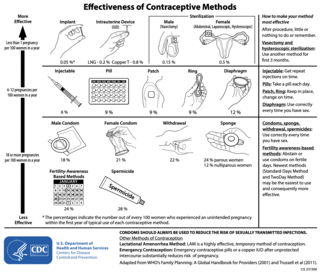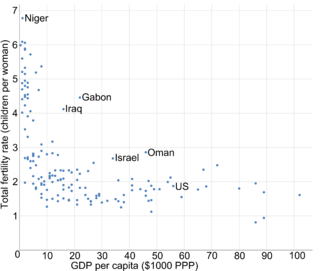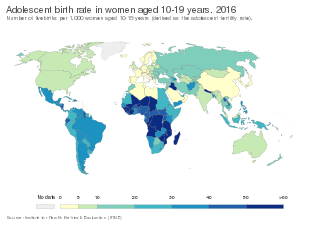Coitus interruptus, also known as withdrawal, pulling out or the pull-out method, is a method of birth control during penetrative sexual intercourse, whereby the penis is withdrawn from a vagina or anus prior to ejaculation so that the ejaculate (semen) may be directed away in an effort to avoid insemination.

Teenage pregnancy, also known as adolescent pregnancy, is pregnancy in a female adolescent or young adult under the age of 20. Worldwide, pregnancy complications are the leading cause of death for women and girls 15 to 19 years old. The definition of teenage pregnancy includes those who are legally considered adults in their country. The WHO defines adolescence as the period between the ages of 10 and 19 years. Pregnancy can occur with sexual intercourse after the start of ovulation, which can happen before the first menstrual period (menarche). In healthy, well-nourished girls, the first period usually takes place between the ages of 12 and 13.
In demography, demographic transition is a phenomenon and theory which refers to the historical shift from high birth rates and high death rates in societies with minimal technology, education and economic development, to low birth rates and low death rates in societies with advanced technology, education and economic development, as well as the stages between these two scenarios. In economic growth, the demographic transition has swept the world over the past two centuries, and the unprecedented population growth of the post-Malthusian period was reversed, reducing birth rates and population growth significantly in all regions of the world, and enabling economies to translate more of the gains of factor accumulation and technological progress into per capita income growth. The demographic transition strengthens economic growth process by three changes: (i) reduced dilution of capital and land stock, (ii) increased investment in human capital, and (iii) increased size of the labor force relative to the total population and changed age population distribution. Although this shift has occurred in many industrialized countries, the theory and model are frequently imprecise when applied to individual countries due to specific social, political and economic factors affecting particular populations.

Family planning is the consideration of the number of children a person wishes to have, including the choice to have no children, and the age at which they wish to have them. Things that may play a role on family planning decisions include marital situation, career or work considerations, financial situations. If sexually active, family planning may involve the use of contraception and other techniques to control the timing of reproduction.
Fertility is the ability to conceive a child. The fertility rate is the average number of children born during an individual's lifetime and is quantified demographically. Conversely, infertility is the difficulty or inability to reproduce naturally. In general, infertility is defined as not being able to conceive a child after one year of unprotected sex. Infertility is widespread, with fertility specialists available all over the world to assist parents and couples who experience difficulties conceiving a baby.

Birth rate, also known as natality, is the total number of live human births per 1,000 population for a given period divided by the length of the period in years. The number of live births is normally taken from a universal registration system for births; population counts from a census, and estimation through specialized demographic techniques. The birth rate is used to calculate population growth. The estimated average population may be taken as the mid-year population.

The Total Fertility Rate (TFR) of a population is the average number of children that are born to a woman over her lifetime if:
- they were to experience the exact current age-specific fertility rates (ASFRs) through their lifetime
- and they were to live from birth until the end of their reproductive life.

Sub-replacement fertility is a total fertility rate (TFR) that leads to each new generation being less populous than the older, previous one in a given area. The United Nations Population Division defines sub-replacement fertility as any rate below approximately 2.1 children born per woman of childbearing age, but the threshold can be as high as 3.4 in some developing countries because of higher mortality rates. Taken globally, the total fertility rate at replacement was 2.33 children per woman in 2003. This can be "translated" as 2 children per woman to replace the parents, plus a "third of a child" to make up for the higher probability of males born and mortality prior to the end of a person's fertile life. In 2020, the average global fertility rate was around 2.4 children born per woman.
Male contraceptives, also known as male birth control, are methods of preventing pregnancy that are used by males or people who produce sperm. The main forms of male contraceptives available today are condoms, vasectomy, and withdrawal, and these methods combined make up less than one-third of global contraceptive use.

Sexual and reproductive health (SRH) is a field of research, health care, and social activism that explores the health of an individual's reproductive system and sexual well-being during all stages of their life. Sexual and reproductive health is more commonly defined as sexual and reproductive health and rights, to encompass individual agency to make choices about their sexual and reproductive lives.

There are many methods of birth control that vary in requirements, side effects, and effectiveness. As the technology, education, and awareness about contraception has evolved, new contraception methods have been theorized and put in application. Although no method of birth control is ideal for every user, some methods remain more effective, affordable or intrusive than others. Outlined here are the different types of barrier methods, hormonal methods, various methods including spermicides, emergency contraceptives, and surgical methods and a comparison between them.
Childlessness is the state of not having children. Childlessness may have personal, social or political significance.
Ansley Johnson Coale, was one of America's foremost demographers. A native to Baltimore, Maryland, he earned his Bachelor of Arts in 1939, his Master of Arts in 1941, and his Ph.D. in 1947, all at Princeton University. A long-term director of the Office of Population Research at Princeton, Coale was especially influential for his work on the demographic transition and for his leadership of the European Fertility Project.

Income and fertility is the association between monetary gain on one hand, and the tendency to produce offspring on the other. There is generally an inverse correlation between income and the total fertility rate within and between nations. The higher the degree of education and GDP per capita of a human population, subpopulation or social stratum, the fewer children are born in any developed country. In a 1974 United Nations population conference in Bucharest, Karan Singh, a former minister of population in India, illustrated this trend by stating "Development is the best contraceptive." In 2015, this thesis was supported by Vogl, T.S., who concluded that increasing the cumulative educational attainment of a generation of parents was by far the most important predictor of the inverse correlation between income and fertility based on a sample of 48 developing countries.

Industrialized and developing countries have distinctly different rates of teenage pregnancy. In Western countries such as the United States, Canada, Western Europe, Australia, and New Zealand, teen parents tend to be unmarried, and adolescent pregnancy is seen as a social issue.

Birth control, also known as contraception, anticonception, and fertility control, is the use of methods or devices to prevent unintended pregnancy. Birth control has been used since ancient times, but effective and safe methods of birth control only became available in the 20th century. Planning, making available, and using human birth control is called family planning. Some cultures limit or discourage access to birth control because they consider it to be morally, religiously, or politically undesirable.

Family planning in India is based on efforts largely sponsored by the Indian government. From 1965 to 2009, contraceptive usage has more than tripled and the fertility rate has more than halved, but the national fertility rate in absolute numbers remains high, causing concern for long-term population growth. India adds up to 1,000,000 people to its population every 20 days. Extensive family planning has become a priority in an effort to curb the projected population of two billion by the end of the twenty-first century.
Fertility factors are determinants of the number of children that an individual is likely to have. Fertility factors are mostly positive or negative correlations without certain causations.

Access to safe and adequate sexual and reproductive healthcare constitutes part of the Universal Declaration of Human Rights, as upheld by the United Nations.
Human reproductive ecology is a subfield in evolutionary biology that is concerned with human reproductive processes and responses to ecological variables. It is based in the natural and social sciences, and is based on theory and models deriving from human and animal biology, evolutionary theory, and ecology. It is associated with fields such as evolutionary anthropology and seeks to explain human reproductive variation and adaptations. The theoretical orientation of reproductive ecology applies the theory of natural selection to reproductive behaviors, and has also been referred to as the evolutionary ecology of human reproduction.













